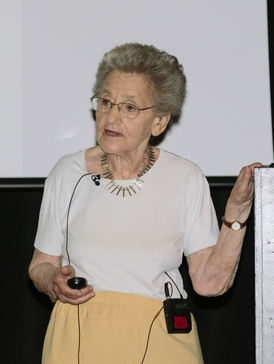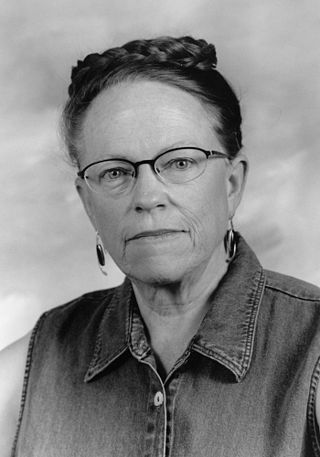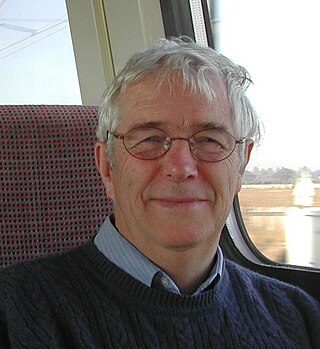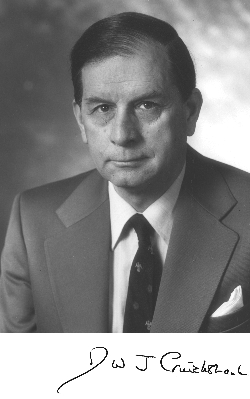Related Research Articles

X-ray crystallography is the experimental science determining the atomic and molecular structure of a crystal, in which the crystalline structure causes a beam of incident X-rays to diffract into many specific directions. By measuring the angles and intensities of these diffracted beams, a crystallographer can produce a three-dimensional picture of the density of electrons within the crystal. From this electron density, the positions of the atoms in the crystal can be determined, as well as their chemical bonds, crystallographic disorder, and various other information.

Sir Alan Roy Fersht is a British chemist at the MRC Laboratory of Molecular Biology, Cambridge, and an Emeritus Professor in the Department of Chemistry at the University of Cambridge. He was Master of Gonville and Caius College, Cambridge from 2012 to 2018. He works on protein folding, and is sometimes described as a founder of protein engineering.

Olga Kennard, Lady Burgen was a Hungarian-born British scientist who specialised in crystallography. She was the founder of the Cambridge Crystallographic Data Centre.
Michael G. Rossmann was a German-American physicist, microbiologist, and Hanley Distinguished Professor of Biological Sciences at Purdue University who led a team of researchers to be the first to map the structure of a human common cold virus to an atomic level. He also discovered the Rossmann fold protein motif. His most well recognised contribution to structural biology is the development of a phasing technique named molecular replacement, which has led to about three quarters of depositions in the Protein Data Bank.

John Maxwell Cowley was an American Regents Professor at Arizona State University. The John M. Cowley Center for High-Resolution Electron Microscopy at Arizona State is named in his honor.
John Cowley was an extraordinarily productive scientist over more than five decades. He made pioneering contributions in the fields of electron microscopy, diffraction and crystallography, all of which brought him widespread recognition. He received the highest awards of the International Union of Crystallography, the Electron Microscopy Society of America and the American Crystallographic Society, and he was honored by election to Fellowship of the Australian Academy of Science, The Royal Society of London, and the American Physical Society. His monograph Diffraction Physics remains the standard reference in the field. His ideas, enthusiasm and basic understanding of electron optics and diffraction phenomena provided a valued source of leadership to many generations of students and co-workers, and he was universally admired by his peers and colleagues as a great and inspiring scientist.
Multi-wavelength anomalous diffraction is a technique used in X-ray crystallography that facilitates the determination of the three-dimensional structure of biological macromolecules via solution of the phase problem.

Jane Shelby Richardson is an American biophysicist best known for developing the Richardson diagram, or ribbon diagram, a method of representing the 3D structure of proteins. Ribbon diagrams have become a standard representation of protein structures that has facilitated further investigation of protein structure and function globally. With interests in astronomy, math, physics, botany, and philosophy, Richardson took an unconventional route to establishing a science career. Richardson is a professor in biochemistry at Duke University.
Thomas Alwyn Jones (born 30 August 1947) is a Welsh biophysicist and a professor at the Uppsala University in Sweden.

S100 calcium-binding protein A12 (S100A12) is a protein that in humans is encoded by the S100A12 gene. Human S100A12, also known as calgranulin C, was first described in 1995.
Acta Crystallographica is a series of peer-reviewed scientific journals, with articles centred on crystallography, published by the International Union of Crystallography (IUCr). Originally established in 1948 as a single journal called Acta Crystallographica, there are now six independent Acta Crystallographica titles:

Mamannamana Vijayan was an Indian structural biologist.

George Guy Dodson FRS FMedSci, was a British biochemist who specialised in protein crystallography at the University of York.
6-phospho-3-hexuloisomerase is an enzyme with systematic name D-arabino-hex-3-ulose-6-phosphate isomerase. This enzyme catalyses the following chemical reaction

Macromolecular structure validation is the process of evaluating reliability for 3-dimensional atomic models of large biological molecules such as proteins and nucleic acids. These models, which provide 3D coordinates for each atom in the molecule, come from structural biology experiments such as x-ray crystallography or nuclear magnetic resonance (NMR). The validation has three aspects: 1) checking on the validity of the thousands to millions of measurements in the experiment; 2) checking how consistent the atomic model is with those experimental data; and 3) checking consistency of the model with known physical and chemical properties.

Randy John Read is a Wellcome Trust Principal Research Fellow and professor of protein crystallography at the University of Cambridge.
George Michael Sheldrick, FRS is a British chemist who specialises in molecular structure determination. He is one of the most cited workers in the field, having over 280,000 citations as of 2020 and an h-index of 113. He was a professor at the University of Göttingen from 1978 until his retirement in 2011.
In 1986 the International Union of Crystallography (IUCr) established the Ewald Prize for outstanding contributions to the science of crystallography. The Ewald Prize is considered the highest prize available to crystallographers apart from the Nobel Prize. The Ewald Prize has been described as prestigious, acclaimed and coveted.

Durward William John Cruickshank, often known as D. W. J. Cruickshank, was a British crystallographer whose work transformed the precision of determining molecular structures from X-ray crystal structure analysis. He developed the theoretical framework for anisotropic displacement parameters, also known as the thermal ellipsoid, for crystal structure determination in a series of papers published in 1956 in Acta Crystallographica.

Władysław Minor also known as Wladek Minor is a Polish-American biophysicist, a specialist in structural biology and protein crystallography. He is a Harrison Distinguished Professor of Molecular Physiology and Biological Physics at the University of Virginia. Minor is a co-author of HKL2000/HKL3000 – crystallographic data processing and structure solution software used to process data and solve structures of macromolecules, as well as small molecules. He is a co-founder of HKL Research, a company that distributes the software. He is also a co-author of a public repository of diffraction images (proteindiffraction.org) for some of the protein structures available in the Protein Data Bank and other software tools for structural biology.
Susan Mary Lea is a British biologist who serves as chief of the center for structural biology at the National Cancer Institute. Her research investigates host-pathogen interactions and biomolecular pathways. She was elected a Fellow of the Royal Society in 2022.
References
- 1 2 3 4 "Professor Eleanor Dodson". University of St Andrews. 23 June 2010. Archived from the original on 31 December 2013. Retrieved 31 December 2013.
- ↑ Wigley, D.B.; Davies, G.J.; Dodson, E.J.; Maxwell, A; Dodson, G (1991). "Crystal structure of an N-terminal fragment of the DNA gyrase B protein". Nature. 351 (6328): 624–629. Bibcode:1991Natur.351..624W. doi:10.1038/351624a0. PMID 1646964. S2CID 4373125.
- ↑ "About staff - Professor Eleanor Dodson". The University of York. 26 March 2013. Retrieved 31 December 2013.
- ↑ Professor Eleanor Dodson FRS Department of Chemistry, Athena SWAN – Charter for Women in Science
- 1 2 "Eleanor Dodson –". Uppsala universitet. Archived from the original on 31 December 2013. Retrieved 31 December 2013.
- ↑ "Fellows". Royal Society. Retrieved 1 December 2010.
- ↑ "ECA Prizes". European Crystallographic Association. August 2009. Archived from the original on 31 December 2013. Retrieved 31 December 2013.
- ↑ "9th Ewald Prize given to Professor E. Dodson". Archived from the original on 18 March 2022.